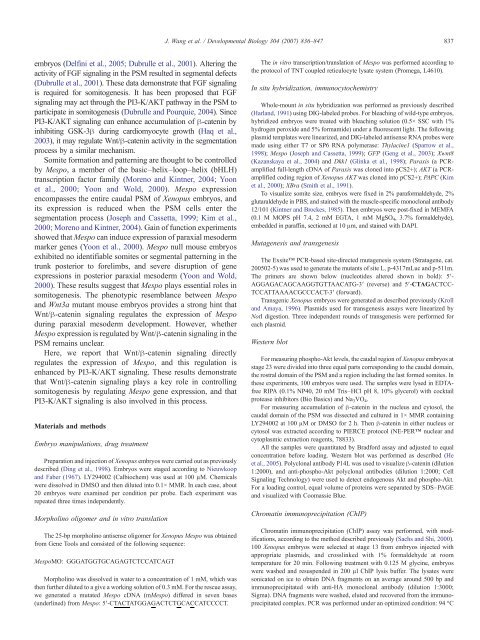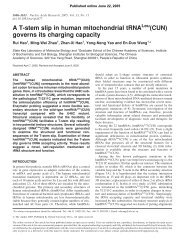2007-DevelopmentalBiology.pdf
2007-DevelopmentalBiology.pdf
2007-DevelopmentalBiology.pdf
Create successful ePaper yourself
Turn your PDF publications into a flip-book with our unique Google optimized e-Paper software.
embryos (Delfini et al., 2005; Dubrulle et al., 2001). Altering the<br />
activity of FGF signaling in the PSM resulted in segmental defects<br />
(Dubrulle et al., 2001). These data demonstrate that FGF signaling<br />
is required for somitogenesis. It has been proposed that FGF<br />
signaling may act through the PI3-K/AKT pathway in the PSM to<br />
participate in somitogenesis (Dubrulle and Pourquie, 2004). Since<br />
PI3-K/AKT signaling can enhance accumulation of β-catenin by<br />
inhibiting GSK-3β during cardiomyocyte growth (Haq et al.,<br />
2003), it may regulate Wnt/β-catenin activity in the segmentation<br />
process by a similar mechanism.<br />
Somite formation and patterning are thought to be controlled<br />
by Mespo, a member of the basic–helix–loop–helix (bHLH)<br />
transcription factor family (Moreno and Kintner, 2004; Yoon<br />
et al., 2000; Yoon and Wold, 2000). Mespo expression<br />
encompasses the entire caudal PSM of Xenopus embryos, and<br />
its expression is reduced when the PSM cells enter the<br />
segmentation process (Joseph and Cassetta, 1999; Kim et al.,<br />
2000; Moreno and Kintner, 2004). Gain of function experiments<br />
showed that Mespo can induce expression of paraxial mesoderm<br />
marker genes (Yoon et al., 2000). Mespo null mouse embryos<br />
exhibited no identifiable somites or segmental patterning in the<br />
trunk posterior to forelimbs, and severe disruption of gene<br />
expressions in posterior paraxial mesoderm (Yoon and Wold,<br />
2000). These results suggest that Mespo plays essential roles in<br />
somitogenesis. The phenotypic resemblance between Mespo<br />
and Wnt3a mutant mouse embryos provides a strong hint that<br />
Wnt/β-catenin signaling regulates the expression of Mespo<br />
during paraxial mesoderm development. However, whether<br />
Mespo expression is regulated by Wnt/β-catenin signaling in the<br />
PSM remains unclear.<br />
Here, we report that Wnt/β-catenin signaling directly<br />
regulates the expression of Mespo, and this regulation is<br />
enhanced by PI3-K/AKT signaling. These results demonstrate<br />
that Wnt/β-catenin signaling plays a key role in controlling<br />
somitogenesis by regulating Mespo gene expression, and that<br />
PI3-K/AKT signaling is also involved in this process.<br />
Materials and methods<br />
Embryo manipulations, drug treatment<br />
Preparation and injection of Xenopus embryos were carried out as previously<br />
described (Ding et al., 1998). Embryos were staged according to Nieuwkoop<br />
and Faber (1967). LY294002 (Calbiochem) was used at 100 μM. Chemicals<br />
were dissolved in DMSO and then diluted into 0.1× MMR. In each case, about<br />
20 embryos were examined per condition per probe. Each experiment was<br />
repeated three times independently.<br />
Morpholino oligomer and in vitro translation<br />
The 25-bp morpholino antisense oligomer for Xenopus Mespo was obtained<br />
from Gene Tools and consisted of the following sequence:<br />
MespoMO: GGGATGGTGCAGAGTCTCCATCAGT<br />
Morpholino was dissolved in water to a concentration of 1 mM, which was<br />
then further diluted to a give a working solution of 0.3 mM. For the rescue assay,<br />
we generated a mutated Mespo cDNA (mMespo) differed in seven bases<br />
(underlined) from Mespo: 5′-CTACTATGGAGACTCTGCACCATCCCCT.<br />
J. Wang et al. / Developmental Biology 304 (<strong>2007</strong>) 836–847<br />
The in vitro transcription/translation of Mespo was performed according to<br />
the protocol of TNT coupled reticulocyte lysate system (Promega, L4610).<br />
In situ hybridization, immunocytochemistry<br />
Whole-mount in situ hybridization was performed as previously described<br />
(Harland, 1991) using DIG-labeled probes. For bleaching of wild-type embryos,<br />
hybridized embryos were treated with bleaching solution (0.5× SSC with 1%<br />
hydrogen peroxide and 5% formamide) under a fluorescent light. The following<br />
plasmid templates were linearized, and DIG-labeled antisense RNA probes were<br />
made using either T7 or SP6 RNA polymerase: Thylacine1 (Sparrow et al.,<br />
1998); Mespo (Joseph and Cassetta, 1999); GFP (Geng et al., 2003); Xwnt8<br />
(Kazanskaya et al., 2004) and Dkk1 (Glinka et al., 1998); Paraxis (a PCRamplified<br />
full-length cDNA of Paraxis was cloned into pCS2+); AKT (a PCRamplified<br />
coding region of Xenopus AKT was cloned into pCS2+); PAPC (Kim<br />
et al., 2000); XBra (Smith et al., 1991).<br />
To visualize somite size, embryos were fixed in 2% paraformaldehyde, 2%<br />
glutaraldehyde in PBS, and stained with the muscle-specific monoclonal antibody<br />
12/101 (Kintner and Brockes, 1985). Then embryos were post-fixed in MEMFA<br />
(0.1 M MOPS pH 7.4, 2 mM EGTA, 1 mM MgSO4, 3.7% formaldehyde),<br />
embedded in paraffin, sectioned at 10 μm, and stained with DAPI.<br />
Mutagenesis and transgenesis<br />
The Exsite PCR-based site-directed mutagenesis system (Stratagene, cat.<br />
200502-5) was used to generate the mutants of site L, p-4317mLuc and p-511m.<br />
The primers are shown below (nucleotides altered shown in bold): 5′-<br />
AGGAGACAGCAAGGTGTTAACATG-3′ (reverse) and 5′-CTAGACTCC-<br />
TCCATTAAAACGCCCACT-3′ (forward).<br />
Transgenic Xenopus embryos were generated as described previously (Kroll<br />
and Amaya, 1996). Plasmids used for transgenesis assays were linearized by<br />
NotI digestion. Three independent rounds of transgenesis were performed for<br />
each plasmid.<br />
Western blot<br />
For measuring phospho-Akt levels, the caudal region of Xenopus embryos at<br />
stage 23 were divided into three equal parts corresponding to the caudal domain,<br />
the rostral domain of the PSM and a region including the last formed somites. In<br />
these experiments, 100 embryos were used. The samples were lysed in EDTAfree<br />
RIPA (0.1% NP40, 20 mM Tris–HCl pH 8, 10% glycerol) with cocktail<br />
protease inhibitors (Bio Basics) and Na 3VO 4.<br />
For measuring accumulation of β-catenin in the nucleus and cytosol, the<br />
caudal domain of the PSM was dissected and cultured in 1× MMR containing<br />
LY294002 at 100 μM or DMSO for 2 h. Then β-catenin in either nucleus or<br />
cytosol was extracted according to PIERCE protocol (NE-PER nuclear and<br />
cytoplasmic extraction reagents, 78833).<br />
All the samples were quantitated by Bradford assay and adjusted to equal<br />
concentration before loading. Western blot was performed as described (He<br />
et al., 2005). Polyclonal antibody P14L was used to visualize β-catenin (dilution<br />
1:2000), and anti-phospho-Akt polyclonal antibodies (dilution 1:2000; Cell<br />
Signaling Technology) were used to detect endogenous Akt and phospho-Akt.<br />
For a loading control, equal volume of proteins were separated by SDS–PAGE<br />
and visualized with Coomassie Blue.<br />
Chromatin immunoprecipitation (ChIP)<br />
Chromatin immunoprecipitation (ChIP) assay was performed, with modifications,<br />
according to the method described previously (Sachs and Shi, 2000).<br />
100 Xenopus embryos were selected at stage 13 from embryos injected with<br />
appropriate plasmids, and crosslinked with 1% formaldehyde at room<br />
temperature for 20 min. Following treatment with 0.125 M glycine, embryos<br />
were washed and resuspended in 200 μl ChIP lysis buffer. The lysates were<br />
sonicated on ice to obtain DNA fragments on an average around 500 bp and<br />
immunoprecipitated with anti-HA monoclonal antibody (dilution 1:3000;<br />
Sigma). DNA fragments were washed, eluted and recovered from the immunoprecipitated<br />
complex. PCR was performed under an optimized condition: 94 °C<br />
837







